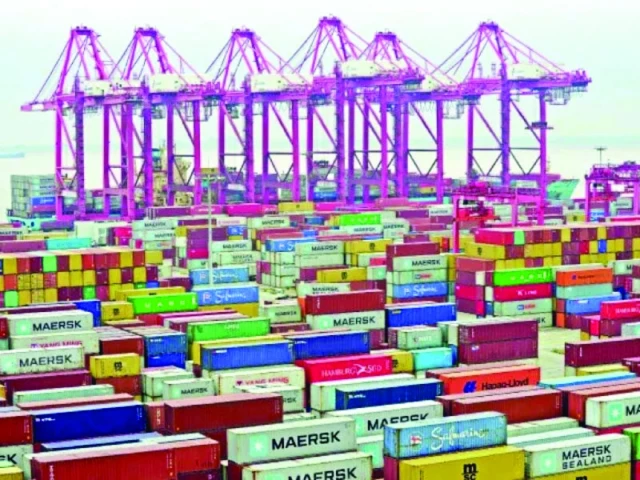Business
Breaking free from boom-bust cycles | The Express Tribune

ISLAMABAD:
There is a general perception that Pakistan’s economy is perpetually trapped in a “boom-and-bust” cycle and will likely remain so. This self-limiting belief has convinced successive governments and the public that any attempt at rapid economic growth is inevitably followed by crisis or stagnation.
It’s a mindset not unlike the myth of Sisyphus, the Greek king condemned by gods to eternally push a boulder uphill, only for it to roll back down just before reaching the summit. Similarly, economic pessimists dismiss every early sign of recovery as part of a futile, exhausting cycle, one that’s destined to end in failure.
The prevailing view is that when a new government comes to power, its first task is to secure an IMF bailout, which provides short-term stability and external financing. This fuels a consumption-led boom, pushing GDP growth to 5% or 6%.
Encouraged by early success, the government increases spending on subsidies and projects. But because this growth lacks export depth or productivity gains, the current account deficit widens, reserves deplete, and the country once again returns to the IMF, restarting the cycle. This raises two questions: does the data confirm that Pakistan has always been trapped in boom-bust cycles, and has it ever outperformed its peers over a sustained period? Both can be answered by comparing Pakistan’s record with India, often seen as a post-1990s growth model.
According to Statisticstimes.com, between 1960 and 2008, Pakistan’s per capita income was higher than India’s for 35 years, while India surpassed Pakistan for only 14 years. Despite volatility, Pakistan performed better overall for most of that period.
But 2008 marked a turning point. Pakistan’s exports began to stagnate, and its GDP growth rate also starting declining, averaging about 3% since then. In contrast, India, Bangladesh, and other regional peers averaged over 6% GDP growth. As a result, Pakistan’s per capita income, which was higher at $1,088 in 2008 compared to India’s $994, fell behind and by 2024 had trailed to $1,643 against India’s $2,300.
So, what changed in 2008? In addition to the global financial crisis, two external shocks hit developing countries: crude oil prices rose by 180% and food commodity prices by 60%. In Pakistan, a newly elected government responded by imposing steep regulatory duties on imports, reversing the trade liberalisation that had been gradually achieved since the 1990s. While oil and food prices normalised by 2009, those duties remained.
Since 2014, additional customs duties have further isolated Pakistan from the booming global trade flows. These new tariff barriers resulted in Pakistan being ranked as having “the second highest effective protection for domestic producers of final consumption goods in the world.” After nearly 17 years of setbacks from protectionist policies, the government has finally recognised that global isolation is unsustainable for a small economy. To lift people out of poverty, as China, Vietnam, and other countries have done, Pakistan must boost productivity and expand exports at a pace comparable to successful developing nations.
The recent budget marks an important step towards trade liberalisation. Though reforms will be phased in over the next five years, they offer hope of putting the country back on a sustainable growth path and reducing dependence on the IMF bailout packages. With the reconfiguration of global supply chains and the opening of the economy, Pakistan could begin to attract foreign investment at levels far beyond the current trickle.
This transition will not be easy. For almost two decades, large industries have been shielded from competition by high tariff walls. Many firms have failed to upgrade their plants or adopt modern technology, leading to higher energy consumption and lower productivity. Consequently, although Pakistan produces several engineering goods, such as household appliances, vehicles, and mobile phones, it cannot compete internationally. Instead, producers prefer to sell domestically, where tariff protection has so far guaranteed higher profits.
Furthermore, a deep-rooted fear of the boom-bust cycle will continue to constrain the economy unless excessive caution is replaced with a more balanced approach that allows for measured risk-taking. Monetary policy illustrates this mindset clearly: Pakistan now has the widest real interest rate gap among its peers, 11% compared to 5.5% in India, despite similar inflation of around 5%. This large disparity continues to stifle investment, slow the growth of large-scale manufacturing, and keep unemployment high.
It is time to acknowledge the economic missteps of the past 17 years and work to regain the lost market share while catching up in GDP growth with peer economies. Pakistan must break free from the self-limiting fear of boom-and-bust cycles and instead pursue bold, forward-looking economic policies.
The decision to re-engage with the global economy and privatise loss-making enterprises is a vital first step, but lasting success will depend on dismantling the regulatory barriers and attracting stronger investment to unlock growth and reduce dependence on external bailouts.
The writer is a member of the PM’s Committee on Tariff Reforms and previously served as Pakistan’s Ambassador to the WTO and FAO’s representative to the UN
Business
Tariff jitters: US consumer confidence slips in December; inflation and jobs worries deepen – The Times of India

US consumer confidence weakened in December, sliding to its lowest level since President Donald Trump rolled out sweeping tariffs earlier this year, as households grew more anxious about high prices, trade levies and job prospects, according to a survey by the Conference Board.The Conference Board said its consumer confidence index fell 3.8 points to 89.1 in December from an upwardly revised 92.9 in November, AP reported. The reading is close to the 85.7 level recorded in April, when the Trump administration introduced import taxes on key US trading partners, AP reported.Consumers’ assessment of current economic conditions saw a sharper drop. The present situation index fell 9.5 points to 116.8, reflecting growing unease about inflation and employment conditions. Write-in responses to the survey showed that prices and inflation remained the biggest concern for consumers, alongside tariffs.Short-term expectations for income, business conditions and the labour market were little changed at 70.7, but remained well below 80 — a threshold that can signal a recession ahead. This was the 11th straight month that expectations stayed under that level.Perceptions of the job market also weakened. The share of consumers who said jobs were “plentiful” fell to 26.7% in December from 28.2% in November, while those who said jobs were “hard to get” rose to 20.8% from 20.1%.The softer sentiment follows recent labour market data showing mixed signals. Government figures released last week showed the US economy added 64,000 jobs in November after losing 105,000 jobs in October. The unemployment rate climbed to 4.6% last month, its highest level since 2021.Economists say the labour market is stuck in a “low hire, low fire” phase, as companies remain cautious amid uncertainty over tariffs and the lingering effects of high interest rates. Since March, average monthly job creation has slowed to about 35,000, down from 71,000 in the year ended March. Federal Reserve chair Jerome Powell has said he suspects those figures could be revised even lower, AP reported.
Business
Government waters down farm inheritance tax plan

Kate WhannelPolitical reporter
 PA Media
PA MediaGovernment proposals to tax inherited farmland have been watered down, with the planned threshold increasing from £1m to £2.5m.
The climbdown follows months of protests by farmers and concern from some Labour backbenchers.
At last year’s Budget, ministers said they would start imposing a 20% tax on inherited agricultural assets worth more than £1m from April 2026, ending the 100% tax relief that had been in place since the 1980s.
In an announcement put out after MPs had left Parliament for the Christmas recess, Environment Secretary Emma Reynolds said: “We have listened closely to farmers across the country and we are making changes today to protect more ordinary family farms.”
“It’s only right that larger estates contribute more, while we back the farms and trading businesses that are the backbone of Britain’s rural communities, ” she said.
Head of the National Farmers’ Union Tom Bradshaw welcomed the change, telling BBC Radio 5 Live it “takes out many family farms from the eye of a pernicious storm”.
Gavin Lane, president of the Country Land and Business Association, said: “The government deserves credit for recognising the flaws in the original policy and changing course.
“However, this announcement only limits the damage – it doesn’t eradicate it entirely.
“Many family businesses will own enough expensive machinery and land to be valued above the threshold, yet still operate on such narrow profit margins that this tax burden remains unaffordable.”
Ben Ardern, a farmer from Derbyshire, told the BBC said it was “a step in the right direction”.
He said the government should “drop it [the tax] for family farms… and just tax the people who have got the money to tax.
“The big corporations who have just buried money into land – they’re not farmers, they have just done it to avoid tax. Farmers haven’t bought land to avoid tax, we’ve bought land to farm it and grow food.”

In the 14 months since the initial proposal was announced, there have been regular protests by farmers outside Parliament.
Some Labour MPs in rural areas have also expressed concern. At a recent parliamentary vote on the plan, a dozen backbenchers abstained and one, Markus Campbell-Savours, voted against.
Campbell-Savours was subsequently suspended for voting against the government, meaning he now sits as an independent MP.
Conservative leader Kemi Badenoch said in a post on social media: “This fight isn’t finished.
“Other family businesses are still affected by Labour’s tax raid, and we will keep pushing until the tax is lifted from them too.”
Liberal Democrat spokesperson Tim Farron MP said: “It is utterly inexcusable that family farmers have been put through over a year of uncertainty and anguish since the government first announced these changes.
“We demand that the government scraps this unfair tax in full and if they refuse to, Liberal Democrats will submit amendments in the new year to bring it down.”
Reform UK deputy leader Richard Tice said: “This cynical climbdown – whilst better than nothing – does little to address the year of anxiety that farmers have faced in planning to protect their livelihoods… with British agriculture hanging by a thread, the government must go further and abolish this callous farms tax.”
In her first Budget in 2024, Chancellor Rachel Reeves announced she would be reversing the 100% inheritance tax relief on agricultural assets that had been in place since the 1980s.
The move would have seen inherited agricultural assets worth over £1m taxed at 20%, half the standard inheritance tax rate, raising an estimated £520m annually by 2029.
The government had argued that the change would protect smaller farms while stopping wealthy investors from buying farmland as a tax loophole.
However, it has now stepped back from the original proposal raising the threshold level to £2.5m.
Coupled with an exemption which allows farmers to pass on assets to their spouses tax-free, this new government concession means a couple could pass on up to £5m in qualifying assets, without paying tax.
Above the threshold, a 50% relief will be applied to the remaining assets.
According to the government, the number of estates in the UK expected to pay more inheritance tax in 2026/27 will be reduced from around 2,000 under the original plans to 1,100 under the new proposal.
The climbdown is the latest in a series of U-turns the government has made since being elected in July 2024.
Earlier this year the government eased cuts to winter fuel payments and backtracked on plans to make £5bn of cuts to the welfare bill.
Business
US economy grows at fastest pace in two years

The US economy picked up speed over the three months to September, as consumer spending jumped and exports increased.
The world’s largest economy expanded at an annual rate of 4.3%, up from 3.8% in the previous quarter. That was better than expected, and marked the strongest growth in two years.
The figures offer a clearer picture of the state of the US economy heading into the end of the year, after data collection had been delayed by the US government shutdown.
The report showed consumer spending rising by 3.5%, compared with 2.5% in the previous quarter.
-

 Business1 week ago
Business1 week agoStudying Abroad Is Costly, But Not Impossible: Experts On Smarter Financial Planning
-

 Fashion5 days ago
Fashion5 days agoIndonesia’s thrift surge fuels waste and textile industry woes
-

 Business1 week ago
Business1 week agoKSE-100 index gains 876 points amid cut in policy rate | The Express Tribune
-

 Sports1 week ago
Sports1 week agoJets defensive lineman rips NFL officials after ejection vs Jaguars
-

 Business5 days ago
Business5 days agoBP names new boss as current CEO leaves after less than two years
-

 Tech5 days ago
Tech5 days agoT-Mobile Business Internet and Phone Deals
-

 Entertainment1 week ago
Entertainment1 week agoPrince Harry, Meghan Markle’s 2025 Christmas card: A shift in strategy
-

 Sports5 days ago
Sports5 days agoPKF summons meeting after Pakistani player represents India in kabaddi tournament










